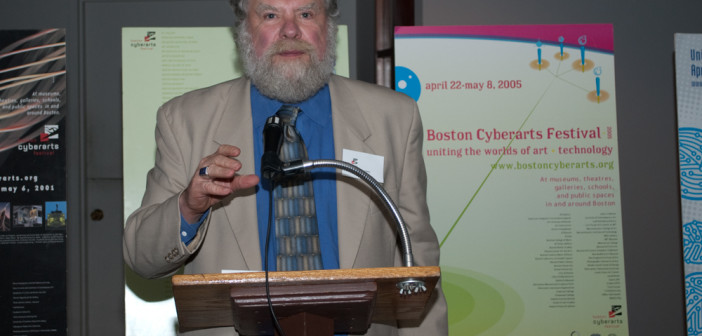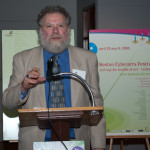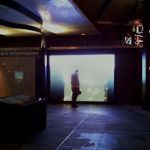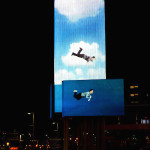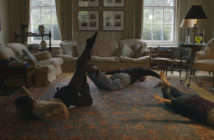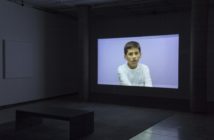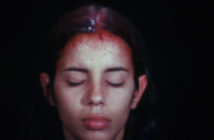George Fifield is a media arts curator, writer, teacher and artist. He is the founder and director of Boston Cyberarts Inc., a nonprofit arts organization, which from 1999 through 2011 produced the Boston Cyberarts Festival. Big Red & Shiny sits down for a conversation with him about the future plans for Boston Cyberarts and its connection to alternative spaces.
BR&S: George, earlier this summer you announced that Cyberarts would no longer be doing the festival, what happened?
Fifield: A lot of things changed in the last year, we have been taking on more projects like the Art on the Marquee at the Boston Convention Center and the screens at the Harbor Island Pavilion on the Greenway Conservancy. Heidi Kayser, Director of the Axiom Center for New and Experimental Media decided that she wanted to go to graduate school and felt it was time to end Axiom. So we decided that I would take over the gallery and call it the Boston Cyberarts Gallery. All of a sudden there were three full time projects and we had just come off of a year long project curating exhibitions at the Atlantic Wharf Gallery.
At that point I realized that the festival had achieved its original mission which was, when I first came up in the idea in 1998, first to get people acknowledging new media and all the other technologies that take place in the different arts including music and dance, and also to shine a light the fact that Boston was really the center of this for many years and no one had really paid attention to that. If that was the mission, I looked at the festival and said, "We won!"
I had a lot of discussions with the Cyberarts Board of Directors and everyone saw the direction we are going in and we all decided that the 2011 Festival would be the last one.
BR&S: How does this change your role, going from an administrator organizing a festival involving dozens of galleries, organizations and events to focusing on a few selected curatorial projects?
Fifield: In fact this lets me do more curating, which is the real love of my life. I am a much better curator than an arts manager, although I became a pretty good arts manager.
BR&S: You are taking over the space that was Axiom Gallery in Jamaica Plain. What are some of the things you are planning for the gallery?
Fifield: The first thing we are doing is that we are opening the Boston Cyberarts Gallery with an ongoing commitment to the Collision Collective, which Axiom also had. I think of the Collision Collective as one of the most important arts groups in the city. They will be able to have regular ongoing exhibitions at the gallery. Their next show opening November 9th will be the first exhibit at the gallery.
We are also working with Art Technology New England. When Cyberarts and Axiom merged in 2009 there was a planning grant to start ATNE, which is a New England based sector of art and technology not just from the perspective of artist but also the perspective of the industries, businesses, academic institutions and non-profits working with art and technology. ATNE brings all of these groups together. ATNE will be putting on a regular series of discussions and networking events in the gallery space. I feel ATNE is an excellent idea and over time I hope having these events in the gallery will incubate these connections and will lead to the group growing beyond Boston and throughout the region.
In terms of other exhibitions, I want to really reach out to artists that I have admired but whom I have not had a chance or a venue to show before, and I want to reach out to curators whose work I admire and goals are simpatico to those of Cyberarts. I will also of course be using the space for some of my own curatorial projects. Part of the focus will be on local and regional artists but I will also be reaching out to national and international artists.
BR&S: Over the last year you have been curating videos on large scale displays that have been going up around the city, as a curator how do you approach working with these displays?
Fifield: This idea of using large screens is something I have been talking about for a long time, urban screens as architecture, screens as interior design and screens as fashion, this is really taking off. People are building wearable media, people are designing spaces with flat screens in their rooms and offices and sheathing the sides of buildings with them, especially in Europe, Korea and Japan.
Each of these displays we are working with in Boston is completely different with the issues and potential to them.
In the case of the marque display at the Boston Convention & Exhibition Center in South Boston, they came to us. The Convention Center wanted to include art along with the convention information, the PSA’s and ads being shown on their 80 foot high display. Making that happen is what we do, so we put calls out for initial proposals last year which was a success and now we are in our 4th round of calls. There has been such a wide range of work that I am thrilled with, from totally abstract, there is figurative, there is fun, silly, dystopian and everything else. Because the board operates 24 hours, we have numerous artist showing works ranging from 15-30 seconds during the day to longer works designed to be shown late night.
It has been interesting watching the artist adapt to this display and realizing the fact that this is not a screen, it is a video sculpture. It has issues and challenges beyond even the biggest rectangle screen, no matter where it is located. This marque is not a rectangle, it has depth, setbacks, it has seven separate panels on three sides of varying shapes and resolutions. And you really have to think about how you will make it work successfully. Some of the artists have actually used every single screen separately, when that happens it is really fun.
Image courtesy Jeffu Warmouth.
The two screens at the Harbor Island Pavilion on the Greenway Conservancy are a different situation, the screens are a six by eight foot rectangle, but they only have 48x64 pixel resolution which is tiny, the lowest resolution where you can make out any sort of recognizable imagery. When we approached the Greenway Conservancy, we said we would not be doing a call, rather we are going to find specific algorithmic artist to write code that will be a constantly changing generative art piece, never the same and designed just for that resolution, with a new artist creating a new work every few months.
BR&S: Throughout the history of Cyberarts, you have collaborated with many alternative venues and organizations, two of the most notable being Axiom and Art Interactive, both of which are now closed. What has been your experience with these spaces?
Fifield: Going back a bit further before Cyberarts, in the early 1990’s I did my first curatorial projects at The Space, which was an alternative gallery started by Stella McGregor, dedicated to installation art on South Street in Boston. In 1993 I did an exhibition called "The Computer is Not Sorry" which was the first exhibition in Boston that included computer installation art. That is how I cut my teeth as a curator, and that is how the DeCordova found me.
Art Interactive was a great concept started by Chuck Lewin. The very first show at Art Interactive was with the group that became the Collision Collective. Cyberarts also collaborated with Art Interactive in several of the festivals. There was a slightly different approach in that Chuck was footing the entire bill for the project himself which was not inexpensive and fundraising proved too difficult. At the end of the day he lost interest and moved on to other things. The financial issues are a big part of the challenge for alternative spaces but it is also keeping people from losing interest.
Alternative spaces have their own ecology, and its not the bureaucratic ecology that a museum has with development officers, directors and curators all working together, rather in an alternative space it is a handful of people doing everything, writing grants, sweeping up, painting walls AND then doing the programming on top of all of that.
To me, the cool thing about Boston is that we are never without alternative spaces, sure sometimes there are more than others, but there is always something springing up somewhere. In my life here in Boston there has never been a time where there has been no alternative spaces. A big part of this is because of all the art schools in Boston, people graduate and they want to show and they want to show their friends. This is basically how Heidi Kayser started Axiom, when she graduated from the Studio for Interrelated media program at Mass Art she wanted a place to show others doing SIM and related art.
Even in this scene where so many organizations thrive and die, there is this extremely healthy and thriving ecology of artists who are working with new technologies, whether it is the Collision Collective members or some other group like Dorkbot, we have these artists and they want to show and there are organizations that pop up where they can show. That is something Boston should be incredibly proud of, this is one of the things that I want Boston Cyberarts Gallery to be a part of.
- George FIfield speaking at the 2009 Boston Cyberarts Festival Gala. Image by James Manning
- Screen at the Harbor Island Pavilion on the Greenway Conservancy. Image courtesy of Boston Cyberarts.
- The 80 foot LED Marquee outside the Boston Convention & Exhibition Center Showing “Fall” by Jeffu Warmouth. Image courtesy Jeffu Warmouth.

